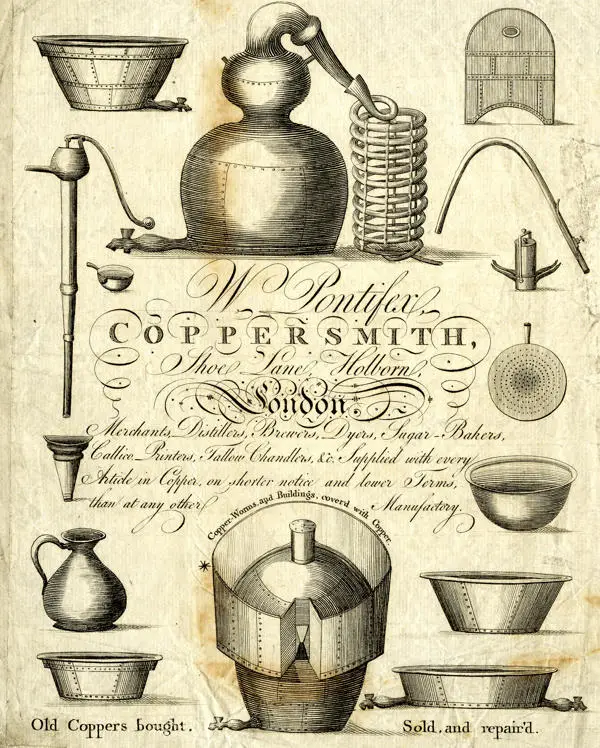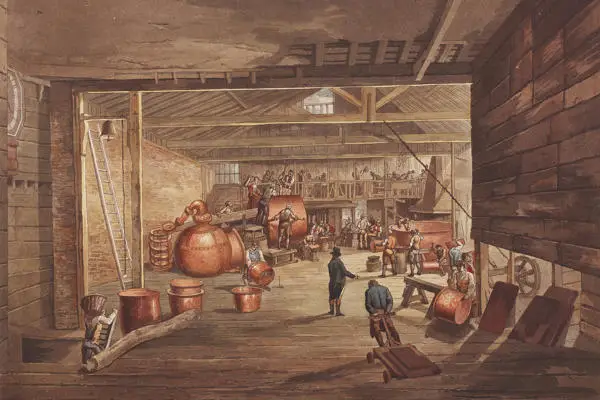Copper-plated City
Archival work in recent years on artists’ supplies, the materials and equipment used by artists, has highlighted an interesting connection between the City of London and the making of prints. Many of the metal plates from which prints were made were manufactured in the City. It is an unexpected connection because although well acknowledged as a base for the printing and publishing of all kinds of prints (and books of course), London’s links with the more industrial stages of the process are less well known. Jeremy Smith from London Metropolitan Archives Graphic Collections team tells more.
Copper, as well as being a very fine anti-microbial metal, well-suited to our times, has been for centuries (and remains) a key material in printmaking for the making of engravings, etchings, aquatints and mezzotints.
In Shoe Lane, between Fleet Street and Holborn, was situated the factory of Pontifex & Co., copper and brass founders. Almost hidden behind a street frontage of old wooden houses, the works of this firm were, from the late eighteenth to the middle nineteenth centuries, one of the most important in London. A fabulous array of copper and brass products issued from their doors including domestic and commercial kitchenware, pans and vats for the brewing industry and for distilling and sugar-refining, pipework for plumbers, springs, coils, boilers and many other gleamingly obscure items. But it was their copper plate sheets for use in printmaking that were a boast.

Their flawlessly smooth plates were widely used in London’s engraving trade. We will never know the full extent of the commercial use of the Pontifex plates for the making of book illustrations, invitations, letterheads, trade cards and so on, as so many of them would be used, and re-used to destruction. But the very high quality of the Pontifex plates meant they were often chosen as an engraving matrix for artist printmakers.
Pontifex developed their own special machine for the polishing of the copper surfaces to the most perfect mirror smoothness and in so doing won the custom of many artists. It is known that Gainsborough, Goya, Blake, Turner, Bartolozzi and Cruikshank all made use of Pontifex copper plates at one time or another. Several museums record that they hold engraving plates by these artists. The Pontifex firm went through many minor name changes as different family members entered or departed, or apprentices became partners. This has meant that in some case the plates have aided the dating of artworks.
Theirs was an international trade and Pontifex plates were used in the studios of Dutch, Italian, Spanish and American artists. The subject matter of the resulting prints could be as varied as the artists, anything from landscape prints to portraiture. The company seem to have advertised strongly through the issue of elaborate trade cards, with the British Museum holding several examples (see illustration above).
A project led by the National Portrait Gallery, under the editorship of Dr Jacob Simon, has since 2006 investigated the entire business of British artists’ suppliers between 1650-1950 with an extremely impressive and useful database which has informed this note.
The Pontifex works in Shoe Lane, close to Farringdon Market and to the Fleet River, was the subject of one of George Dodd’s articles ‘Days in the Factories’ (1843) which sets out on a floor by floor tour of the factory. Clearly it was an impressively well organised operation with separate departments for things like copper beating or “planishing”, the making of coils and pipework, and the all-important smoothing process for copper plates destined for use in engraving. The writer gives a vivid impression of the ringing din arising from the hammering, clanging and clashing of metal.

Pontifex (as Pontifex and Wood, London) were sufficiently prominent to represent metal working with a room-sized display at the 1851 Great Exhibition, their installation photographed for inclusion in the ‘Reports by the Juries’.
In about 1806 an aquatint by W.H. Pyne and J.C.Nattes (illustrated above) gives a wonderful impression of the purposeful activity going on behind the houses in Shoe Lane. The print itself may even have been produced from a Pontifex copper plate.